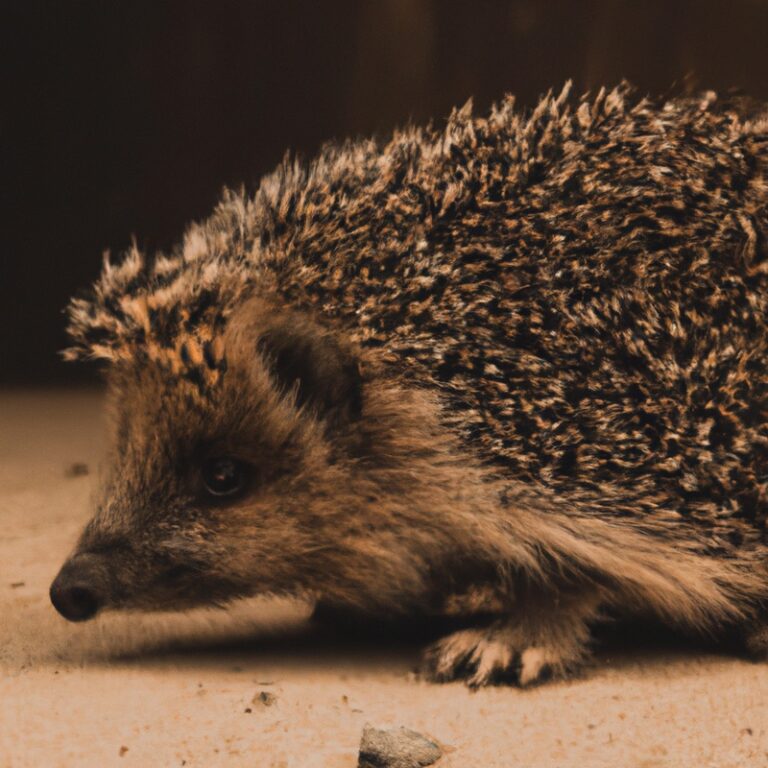How To Create a Hedgehog-Friendly Garden?
Key Takeaways:
- Provide plenty of hiding places in your garden to create a friendly habitat for hedgehogs.
- Avoid using pesticides and chemicals to maintain a safe environment for hedgehogs.
- Install a hedgehog house to provide shelter and encourage hedgehogs to visit your garden.
- Create a hedgehog highway to allow easy access for hedgehogs to move between gardens.
Are you ready to transform your garden into a haven for adorable, prickly visitors?
Creating a hedgehog-friendly garden not only benefits these charming creatures, but also promotes biodiversity and adds a touch of wild beauty to your outdoor space.
By understanding hedgehog behavior and habitat requirements, you can design the perfect haven for them.
From landscaping tips to providing food and water, we’ll guide you through the steps to create a sanctuary that hedgehogs will love.
So, grab your gardening gloves and let’s dive into the world of hedgehog conservation!
| Actions | |
|---|---|
| 1. Provide shelter | Plant dense shrubs and hedges, create log piles, or install hedgehog houses. |
| 2. Give access | Create small gaps or openings on fences and walls to allow hedgehogs to enter and exit the garden. |
| 3. Ensure a water source | Keep a shallow dish of fresh water in your garden. |
| 4. Avoid using pesticides | Avoid using pesticides or chemicals that can harm hedgehogs or their food sources. |
| 5. Provide food | Leave out food suitable for hedgehogs, such as cat food or specialized hedgehog food. |
| 6. Create a wildlife-friendly garden | Encourage a variety of wildlife-friendly plants and flowers to attract insects, a food source for hedgehogs. |
| 7. Create safe pathways | Avoid using slug pellets on pathways and ensure there are no hazards that can harm hedgehogs. |
Benefits of Creating a Hedgehog-Friendly Garden
Creating a hedgehog-friendly garden has several benefits for both the hedgehogs and your garden’s ecosystem.
Hedgehog Conservation Importance
Hedgehog Conservation is crucial for preserving these adorable creatures for future generations. Hedgehogs play a vital role in maintaining ecosystems by controlling insect populations.
By providing hedgehogs with suitable habitats and protecting their natural environments, we can support their survival.
Additionally, hedgehogs are indicators of a healthy environment, so taking steps to conserve them helps to maintain overall biodiversity. Let’s join hands in protecting hedgehogs and ensuring a bright future for these delightful animals.
Promoting Biodiversity in Your Garden
Promoting biodiversity in your garden is important for the health of the ecosystem.
Here are a few simple ways you can do it:
- Plant a variety of native plants and flowers to attract different species of pollinators, birds, and insects.
- Provide water sources like birdbaths or shallow dishes with fresh water.
- Create shelter by leaving patches of long grass or building hedgehog-friendly structures like log piles or hibernation boxes.
- Avoid using pesticides and opt for natural pest control methods instead.
- Encourage natural decomposition by leaving fallen leaves and organic matter in your garden.
These small changes can make a big difference in supporting diverse wildlife and creating a thriving garden ecosystem.
Understanding Hedgehog Behavior and Habitat Requirements
Hedgehog Behavior and Habits: Get to know the natural behaviors and habits of hedgehogs. Hedgehog Habitat Requirements: Learn about the essential elements needed to create a suitable environment for hedgehogs.
Hedgehog Behavior and Habits
Hedgehogs are nocturnal creatures, which means they are most active at night.
They have poor eyesight but rely on their excellent sense of smell and hearing to navigate their surroundings.
Hedgehogs are great climbers and swimmers, but they tend to be slow-moving on land.
They are primarily insectivores, feeding on insects like beetles, slugs, and worms.
Hedgehogs often roll into a ball when they feel threatened, using their spines for protection.
Providing hedges and dense vegetation can create a safe habitat for these adorable creatures.

Hedgehog Habitat Requirements
Hedgehogs require specific habitat conditions to thrive. They need access to both sheltered areas and open spaces.
Providing a variety of vegetation, such as bushes, grass, and trees, will give them places to hide and forage.
Creating a hedgehog highway by removing barriers like fences or installing gaps will allow them to roam freely. Avoid using pesticides and chemicals in your garden, as these can harm hedgehogs and their food sources.
Leave areas of your garden undisturbed to create a safe space for nesting and hibernation.
Creating the Perfect Hedgehog-Friendly Garden
To create the perfect hedgehog-friendly garden, focus on landscaping, providing food and water, and creating safe shelter.
Hedgehog-Friendly Landscaping
To create a hedgehog-friendly garden, there are a few landscaping tips you can keep in mind. First, provide natural shelter by leaving areas of long grass and piles of leaves or branches.
Second, create a hedgehog highway by cutting small holes in fences or walls.
This will allow hedgehogs to move freely between gardens. Third, avoid using pesticides and slug pellets, as these can be harmful to hedgehogs.
Lastly, provide a water source like a shallow dish to keep hedgehogs hydrated.

Providing Food and Water for Hedgehogs
Hedgehogs need a reliable source of food and water in your garden. When providing food for hedgehogs, you can offer specialized hedgehog food or leave out cat or dog food, along with water, in a shallow dish.
Avoid giving them milk or bread, as it can be harmful to their digestive systems.
Additionally, you can create a hedgehog-friendly habitat by leaving areas of your garden undisturbed, providing dense vegetation and log piles for shelter, and avoiding the use of pesticides.
Creating Safe Shelter for Hedgehogs
Creating safe shelter for hedgehogs is essential for their survival. Here are some tips to provide a cozy home for these adorable creatures in your garden:
- Create piles of logs, leaves, and branches to offer natural hiding places.
- Install a hedgehog house or box in a quiet and secluded area of your garden.
- Avoid using chemicals and pesticides that may harm hedgehogs.
- Ensure there are small openings in fences or walls to allow hedgehogs to easily access your garden.
- Provide fresh water and a shallow dish for hedgehogs to drink from and bathe in.
By implementing these simple steps, you can create a safe and welcoming environment for hedgehogs to thrive in your garden.
Planting the Right Vegetation for Hedgehogs
To create a hedgehog-friendly garden, it’s important to choose native plants, create hedges and shrubbery, and incorporate wildflower areas.
Choosing Native Plants
Choosing native plants for your garden is a great way to create a hedgehog-friendly environment. Native plants provide the right habitat and food sources for hedgehogs, as they have evolved to thrive in the local ecosystem.
Look for plants that are naturally found in your region, as they will require less maintenance and attract local insects and other invertebrates that hedgehogs like to eat.
Some examples of native plants include lavender, foxgloves, and hawthorn. So, go native and give hedgehogs a helping hand in your garden!
Creating Hedges and Shrubbery
Creating hedges and shrubbery is a key aspect of a hedgehog-friendly garden.
These provide essential habitats and shelter for hedgehogs.
When planting hedges or shrubs, choose ones with dense foliage that will provide a safe and secure space for hedgehogs to hide.
Native species such as hawthorn, blackthorn, and hazel are great choices.
Additionally, avoid the use of pesticides or chemicals on these plants, as they can harm hedgehogs.
Regularly maintaining and pruning your hedges will ensure they remain a suitable habitat for these wonderful creatures.
Incorporating Wildflower Areas
To incorporate wildflower areas in your garden, start by choosing an open, sunny spot.
Clear any existing vegetation and prepare the soil by removing weeds and raking it.
Scatter wildflower seeds evenly over the soil and lightly press them in.
Water the area gently to keep it moist but not saturated.
As the wildflowers start to grow, avoid using chemical fertilizers or pesticides.
Instead, let nature take its course.
These beautiful wildflower areas will not only enhance the beauty of your garden but also provide a valuable habitat for hedgehogs and other wildlife.
Managing Pest Control Naturally
For natural pest control, try avoiding chemical pesticides and encouraging natural pest predators.
Avoiding Chemical Pesticides
To avoid using chemical pesticides in your garden, there are a few simple steps you can take.
- Encourage natural predators like birds, ladybugs, and spiders to keep pests under control.
- Plant a diverse range of flowers, herbs, and vegetables to attract beneficial insects and create a balanced ecosystem.
- Use physical barriers like nets, fences, or row covers to protect vulnerable plants from insects.
- Practice good garden hygiene by removing plant debris, cleaning up spills, and keeping the area tidy.
- Consider using organic, non-toxic alternatives such as neem oil, soap sprays, or companion planting to manage pest problems.
Encouraging Natural Pest Predators
Encouraging natural pest predators is a great way to manage pests in your garden. To attract these helpful creatures, provide them with a habitat they can thrive in.
Install birdhouses and birdbaths to attract birds, who eat insects.
Leave patches of dense vegetation to provide cover for frogs, toads, and beneficial insects like ladybugs. Avoid using pesticides that can harm these predators.
Additionally, avoid using chemical fertilizers excessively, as they can disrupt the balance of predator-prey relationships.
By creating a welcoming environment for natural pest predators, you can help maintain a healthy ecosystem in your garden.
Ensuring Hedgehog Safety in Your Garden
Make your garden safe for hedgehogs by reducing hazards and dangers and by installing suitable fences or barriers.
Reducing Hazards and Dangers
Reducing hazards and dangers in your garden is essential to create a safe environment for hedgehogs. Here are some tips:
- Clear away any clutter, such as tools or garden equipment.
- Ensure there are no gaps or holes in fences or walls that hedgehogs can get stuck in.
- Check for harmful chemicals, like pesticides or slug pellets, and use natural alternatives.
- Remove any potential hazards, like ponds without escape ramps or netting that hedgehogs could become entangled in.
- Avoid using wire mesh or fencing with small gaps that can trap hedgehogs.
Taking these precautions will help keep your garden hedgehog-friendly and reduce any risks they may encounter.
Fencing and Hedgehog-Friendly Barriers
To keep hedgehogs safe in your garden, it’s important to consider the fencing and barriers you have in place. Make sure there are no gaps larger than 13cm at the bottom of your fences so hedgehogs can’t squeeze through.
Avoid barbed wire or mesh that hedgehogs can get tangled in.
You can also create hedgehog-friendly barriers by digging a shallow trench around the perimeter of your garden and filling it with rocks or gravel. This will deter hedgehogs from trying to climb over.
Educating and Involving Your Community
Get your community involved and educated about hedgehogs by raising awareness and encouraging neighbors to create hedgehog-friendly gardens.
Raising Awareness about Hedgehogs
To raise awareness about hedgehogs, start by sharing information about their declining populations and the importance of protecting them.
Share facts, tips, and resources through social media posts, blog articles, or community newsletters.
Encourage others to create hedgehog-friendly gardens, avoiding pesticides, providing shelter, and leaving out fresh water and food.
Partner with local organizations or schools to host educational events or workshops.
Engage your community in citizen science projects or volunteering opportunities that benefit hedgehogs.
Together, we can make a difference for these adorable creatures!
Encouraging Neighbors to Create Hedgehog-Friendly Gardens
To encourage your neighbors to create hedgehog-friendly gardens, start by sharing your own experiences and enthusiasm.
Talk about how rewarding it is to have these delightful creatures visit your yard.
Offer practical tips, such as providing shelter, access to water, and creating hedgehog highways by making small holes in fences.
Suggest using natural pest control methods instead of harmful chemicals, as this benefits both hedgehogs and the environment.
Share resources like articles, websites, or local organizations that provide guidance on creating hedgehog-friendly environments.
Don’t forget to emphasize how small changes can make a big difference in supporting hedgehog populations.
Frequently Asked Questions about Creating a Hedgehog-Friendly Garden
Can hedgehogs be kept as pets?
Hedgehogs can be kept as pets, but there are a few important things to consider. They have specific dietary and environmental needs, and their quills can be prickly.
It’s crucial to provide them with the proper habitat, including a spacious cage with appropriate bedding and hiding spots.
Additionally, they require a balanced diet of specially formulated hedgehog food, supplemented with insects and vegetables. Regular handling and socialization are important for their well-being.
Research and preparation are essential before deciding to keep a hedgehog as a pet.
How do I attract hedgehogs to my garden?
To attract hedgehogs to your garden, create a welcoming habitat by providing shelter like log piles or hedgehog houses.
Make sure to leave areas of your garden wild and untidy, as hedgehogs thrive in natural environments.
Ensure there’s access to fresh water, either through a shallow dish or a pond.
Avoid using chemical pesticides, as they can harm hedgehogs.
Also, leave out food like cat or dog food, or specially formulated hedgehog food.
Remember, creating a hedgehog-friendly garden is about providing a safe and natural space for these lovely creatures!
What should I do if I find an injured or sick hedgehog?
If you find an injured or sick hedgehog, it’s important to take immediate action. Here’s what you should do:
- Approach the hedgehog with caution, using gloves or a towel to protect yourself and the hedgehog.
- Place the hedgehog in a box or crate lined with a towel or newspaper.
- Provide a shallow dish of water and some cat or dog food for the hedgehog to eat.
- Contact a local wildlife rescue or veterinarian who specializes in treating hedgehogs.
- Follow their advice and instructions for further care or transportation. Remember, it’s crucial to seek professional help in these situations.
Final Verdict
Creating a hedgehog-friendly garden is not only beneficial for these adorable creatures, but also for the overall biodiversity of your backyard.
By understanding their behavior and habitat requirements, you can provide the perfect environment for hedgehogs to thrive.
Implementing landscaping techniques, planting the right vegetation, managing pest control naturally, ensuring hedgehog safety, and educating your community are key steps in creating a hedgehog-friendly garden.
By taking these actions, you can contribute to the conservation of hedgehogs and promote a healthy and thriving ecosystem in your own backyard.
Together, we can make a difference and ensure a brighter future for hedgehogs and other wildlife.







